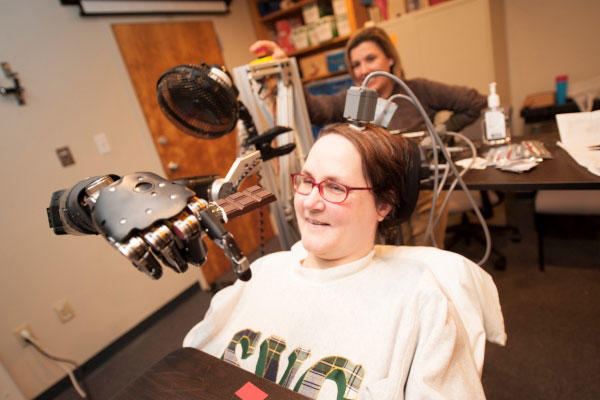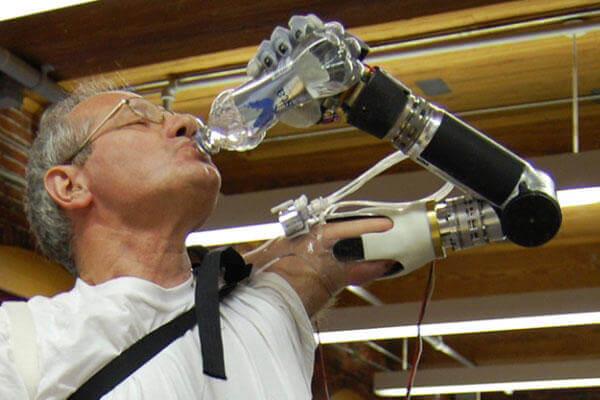An experimental Pentagon program has already developed two types of a highly advanced, Terminator-like prosthetic arm.
What's more, a quadriplegic woman with sensors implanted onto her brain controlled one of the robotic limbs to grab a cup, shake hands and eat a chocolate bar. She even flew an F-35 Joint Strike Fighter simulator using just her thoughts.
Now, the Defense Advanced Research Projects Agency (DARPA) wants to expand on that cutting-edge work to build other potential breakthrough medical technologies, including a pacemaker-sized device that might someday improve the memory of troops who suffered a traumatic brain injury. Think of it as a hard drive of sorts for the brain.
"We know we need a next-generation device that doesn't exist today," said Justin Sanchez, a program manager in DARPA's Biological Technologies Office in Arlington, Virginia. "That's what these new programs are all about -- not only understanding the brain and these conditions, but building the hardware that enables us to address those issues. You need both."
Memory Chip
Over more than a decade of wars in Iraq and Afghanistan, roadside bombs and other explosive devices took a toll on the U.S. military. An estimated half to two-thirds of the more than 7,100 Americans killed or wounded in combat were victims of such blasts and some 1,800 lost limbs, according to USA Today. Hundreds of thousands more suffered from a traumatic brain injury (TBI).
While researchers have been scanning the brain for years, very little is known about memory, which is stored in the side parts of the brain known as temporal lobes, Sanchez said. Like epileptic patients, troops who damage this part of the brain can suffer from memory loss and other issues.
One of DARPA's newer projects, Restoring Active Memory, seeks to build a prosthetic device that could aid in the formation and recall declarative memory, a form of long-term memory that can be recalled such as a fact. For example, a future experiment might involve a patient who is asked to identify a series of faces and names with the aid of an implant.
"The twist on this is he or she will be interacting with a prosthetic device," Sanchez said. "So at some face and name presentations, maybe we'll stimulate the part of the brain that is involved in the memory formation and see if there are particular patterns of stimulation that can facilitate the formation and recall of that memory."
Terminator Arm
The research builds on the work of a precursor program, called Revolutionizing Prosthetics, which dates back almost a decade and reflects the cornerstone of the agency's research into neural signaling.
Jan Scheuermann, one of two patients in the program, in 2012 agreed to let surgeons at the University of Pittsburgh Medical Center implant a pair of pea-sized electrodes onto her left motor cortex -- which controls movement -- and connect her to a robotic arm. She hoped she might feed herself for the first time in a decade. She did that and more.
Scheuermann, a 55-year-old mother of two who became paralyzed in middle-age due to a rare neurological disorder known as spinocerebellar degeneration, became so adept at manipulating the arm developed by Johns Hopkins University Applied Physics Laboratory that her participation in the study was extended until October, when the electrode arrays were removed.
"That is the first program in the agency where you have humans interacting with really advanced prosthetic devices to do something extremely useful," Sanchez said.
Reading the Mind
The sensors on Scheuermann's brain measured just four-millimeters long, yet included hundreds of contact points designed to pick up signals from individual brain cells called neurons.
"When you intend to move your arm, for example, there are certain places in your brain that become active, the neurons that are there become active, and that activity can occur when you physically move your arm or even if you imagine moving your arm," Sanchez said.
The signals were relayed to a computer running software that matched the activity to patterns associated with physical movements, such as raising or lowering an arm. Scientists used vector mathematics to build algorithms that determined the intended motion of the not only the arm, but also the wrist and fingers. The code translated into operating instructions for the robotic prosthesis.
"Neurons in this particular part of your brain are tuned to certain movement directions," Sanchez said. "You can imagine how you can use that information to operate a robotic arm. Once you know those associations, you can say, ‘Oh, whenever I see that guy firing, I'm trying to go in this direction."
Flying the F-35
While the program's potential real-world applications aren't limited to prosthetics, patients won't be flying drones into combat anytime soon. When Scheuermann piloted the F-35 simulator, she didn't drop bombs or launch missiles. Rather, she simply cruised along -- sometimes erratically -- and tried to bank the aircraft on simple flight patterns.
The process of linking her brain to the aircraft's motion was similar to the robotic arm. Scientists would tell her to imagine trying to steer the plane to the right and left, and then would have to figure out how the neural activity would connect to control of the rudders.
"You have to try to find this functional mapping," Sanchez said. "This is a real core part of this from a science perspective: How do you learn what those signals in the brain mean when you intend to do something and how do they relate to the device you're trying to actuate, whether it's a robotic arm or an airplane?"
Scheuermann also virtually piloted a small Cessna plane around the Eiffel Tower in Paris -- an experience she found "liberating," Sanchez said.
"That's a really powerful statement," he said. "We think of neurotechnology as hardware, but we don't often think about it in terms of how it can improve somebody's life or change somebody's life."
Bringing Back Sensation
The next and final phase of the program will seek to reverse the signaling process by understanding the patterns for sensation in the central nervous system.
"It's really easy to say, ‘We want to bring sensation back,' but it's really difficult to actually do it," Sanchez said. "You have to go to a different part of the brain that's involved in the perception of touch -- the primary central cortex -- and again the challenge is the same: You have an electronic device that is measuring something and we need to translate that into signals that the brain understands."
His office is working to identify potential civilian patients for the program. The agency doesn't perform experiments on troops, even though the research is designed to help those who serve.
"Military personnel make the ultimate sacrifice," Sanchez said. "They serve our nation and their lives often are changed through their injury. The very least we can do is develop a technology that will help to improve their quality of life. We have to stay true to that. It's essential."
Reversible Procedure
In the early 2000s, connecting a brain to a robotic prosthesis would have required multiple rooms full of computers, cables and other hardware. While its recent work proved it could be done with more advanced systems and less space, the agency still wants much smaller components.
"All of the new programs have fundamentally by their design the goal of developing medical devices that are fully implantable -- the size of a cardiac pacemaker that could be implanted somewhere in the body," Sanchez said.
Under another new effort called Systems-Based Neurotechnology for Emerging Therapies (Subnets), DARPA is funding the development of implantable devices designed to more precisely identify and treat psychiatric diseases.
"All of these procedures, at least the ones we've talked about thus far, are reversible," he added. "Neurotechnology is being designed in such a way that it's reversible, so if it's not providing a benefit for you, you don't use it. You just take it out."
-- Brendan McGarry can be reached at Brendan.McGarry@military.com.




























